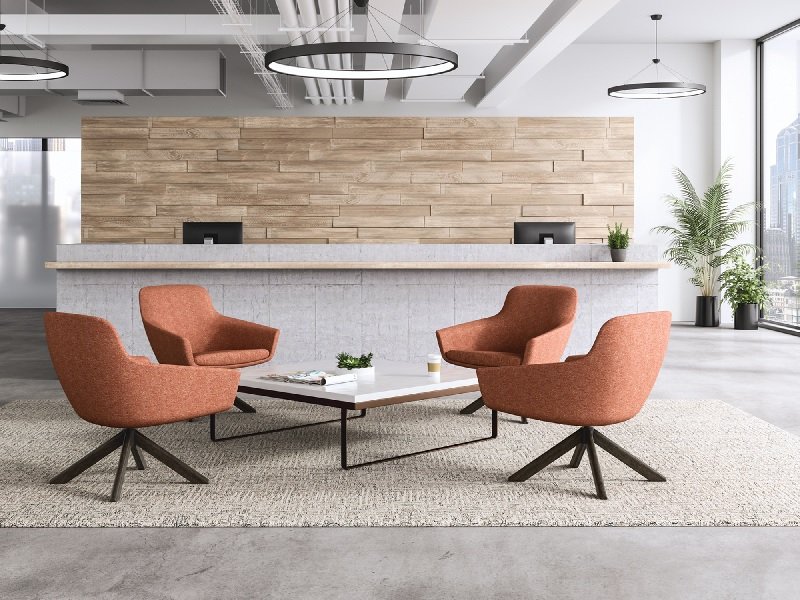In today’s dynamic work environment, collaboration is key to innovation and success. The design and layout of your office play a crucial role in fostering collaboration among employees. Office chairs and office furniture are not just functional elements; they are instrumental in creating a workspace that encourages teamwork, communication, and creativity.
Encouraging Movement and Flexibility
One of the primary roles of office chairs in a collaborative workspace is to promote movement and flexibility. Traditional office setups often limit mobility, confining employees to their desks. However, modern office chairs are designed with mobility in mind, featuring swivel bases and smooth-rolling casters that allow employees to move easily around the workspace. This mobility is essential in a collaborative environment, enabling team members to gather quickly for impromptu meetings, brainstorming sessions, or collaborative projects.
Moreover, adjustable office chairs cater to various seating preferences, making it easier for individuals to find a comfortable position when working together. The ability to adjust seat height, armrests, and back support ensures that everyone can maintain proper posture and comfort during long meetings, reducing fatigue and promoting sustained collaboration.
Creating a Comfortable and Inviting Atmosphere
Comfort is a key factor in encouraging collaboration. When employees are comfortable, they are more likely to engage in discussions and contribute ideas. High-quality office chairs that provide ergonomic support play a vital role in this. Chairs with adequate lumbar support, cushioning, and adjustability help reduce physical discomfort, allowing employees to focus on the task at hand rather than on aches and pains.
In addition to comfort, the aesthetics of office furniture contribute to creating an inviting atmosphere. Sleek, modern office furniture can make the workspace feel more open and accessible, encouraging employees to gather and interact. The choice of materials, colors, and design elements in office chairs and other furniture can reflect the company’s culture and values, creating a space that inspires collaboration.
Facilitating Communication and Interaction
Office furniture layout has a significant impact on how employees communicate and interact. In a collaborative workspace, traditional cubicles and isolated desks are replaced with open-plan layouts that encourage face-to-face communication. Office chairs that are easy to move and reposition enable employees to quickly form groups, fostering spontaneous conversations and idea exchanges.
Shared workspaces, such as conference tables and communal desks, are also integral to collaboration. These spaces require office furniture that supports group activities, such as chairs that can be easily arranged around a table or pushed aside to create an open area. The design of these areas should encourage both formal meetings and informal discussions, allowing employees to interact in a variety of settings.
Supporting Different Types of Collaboration
Collaboration takes many forms, from small group discussions to large team meetings and everything in between. The right office chairs and furniture can support these different types of collaboration by providing versatile seating options. For example, ergonomic chairs with a full range of adjustments are ideal for long, focused meetings, while lightweight, stackable chairs can be quickly set up for a larger gathering.
In addition, office furniture such as modular desks and movable partitions allow for quick reconfiguration of the workspace to suit different collaborative needs. This flexibility ensures that the workspace can adapt to the evolving demands of the team, whether it’s for a project brainstorming session, a one-on-one meeting, or a department-wide presentation.
Enhancing Team Collaboration Through Design
The design of office furniture can significantly impact team collaboration. Furniture that is designed with collaboration in mind often features integrated technology, such as built-in power outlets, USB ports, and wireless charging stations. These features make it easier for teams to connect devices, share information, and work together seamlessly.
Furthermore, collaborative furniture often includes features that encourage teamwork, such as large work surfaces for spreading out materials, whiteboards for brainstorming, and storage solutions for keeping shared resources organized. The thoughtful design of these elements ensures that teams have everything they need to work together efficiently and effectively.
Balancing Privacy and Openness
While open-plan offices are great for collaboration, they can sometimes lead to distractions. It’s important to strike a balance between openness and privacy in a collaborative workspace. Office furniture can help achieve this balance by providing flexible solutions that offer both communal areas and private spaces.
Acoustic office furniture, such as soundproof partitions, screens, and chairs with high backs, can create quiet zones where employees can focus on individual tasks or hold private discussions without disrupting others. At the same time, the openness of the overall layout allows for easy interaction and collaboration when needed. By offering a variety of workspaces within the office, employees can choose the environment that best suits their current task, whether it’s collaborating with others or working independently.
Reflecting Company Culture
The choice of office chairs and furniture also plays a role in reflecting and reinforcing company culture. A workspace that is designed with collaboration in mind signals to employees that teamwork and communication are valued. The style, color, and arrangement of office furniture can create a cohesive environment that aligns with the company’s identity, making employees feel more connected to their work and each other.
For example, a tech company might opt for modern, innovative furniture designs that reflect its forward-thinking ethos, while a creative agency might choose colorful, unconventional furniture that inspires creativity. By carefully selecting office chairs and furniture that embody the company’s culture, you can create a workspace that fosters collaboration and engagement.
Future-Proofing the Collaborative Workspace
As work environments continue to evolve, it’s essential to choose office furniture that can adapt to future changes. Investing in high-quality, durable office chairs and furniture ensures that your workspace remains functional and collaborative for years to come. Look for furniture with modular designs, reconfigurable components, and timeless aesthetics that can grow and change with your team’s needs.
Sustainability is also becoming an increasingly important consideration in office furniture selection. Opting for eco-friendly materials and products not only supports environmental responsibility but also appeals to employees who value sustainability, further enhancing collaboration and team morale.
Office chairs and office furniture are more than just functional items; they are fundamental in shaping a collaborative workspace. By focusing on ergonomics, flexibility, comfort, and thoughtful design, you can create an environment where employees feel supported, engaged, and inspired to work together. As you plan your office layout, consider how your choice of furniture can promote the collaboration and creativity essential to your organization’s success.



